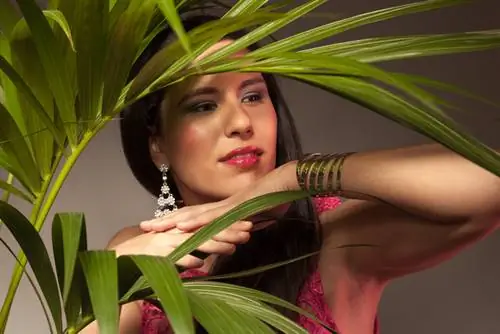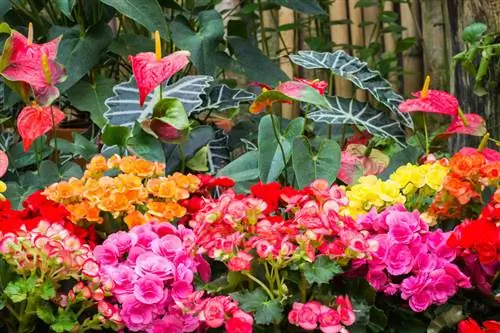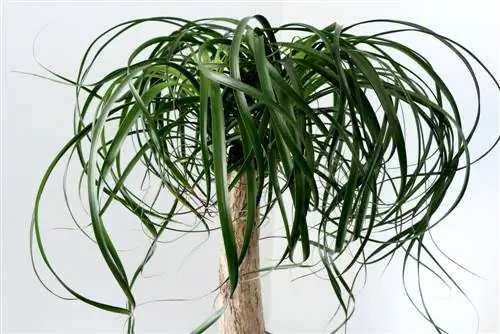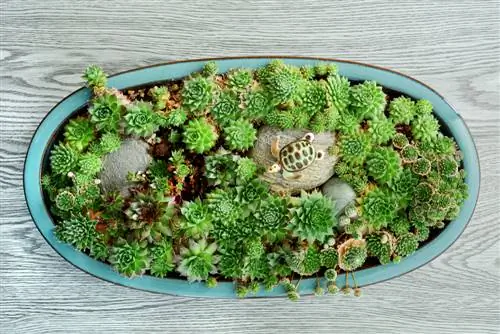- Author admin [email protected].
- Public 2023-12-16 16:46.
- Last modified 2025-01-23 11:20.
This palm tree, whose Latin name is Howea forsteriana, is one of the most common species found in our homes. The natural distribution area is the Lord Howe Islands near Australia, where it can reach a height of up to 17 meters. The gently overhanging, feathery fronds appear extremely elegant. Although its cultivation is quite uncomplicated, there are also some important care details to consider for this attractive palm tree.
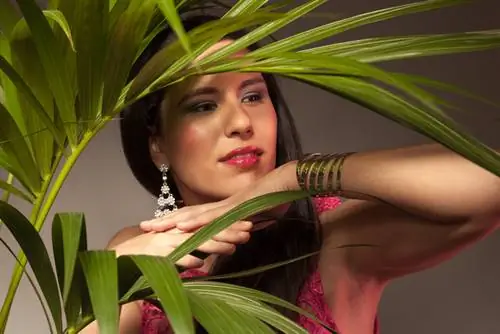
How do you properly care for a Kentia palm?
Kentia palm care includes regular watering of the slightly damp ball with low-lime water, fertilizing in summer, repotting every two years and removing dead fronds. The plant also requires bright indirect light, increased humidity and pest control.
Water requirements
This palm tree doesn't like it very dry or very wet. Always keep the root slightly moist and water whenever the top centimeters of the substrate feel dry.
Like all palm plants, the water for the Kentia palm must not be too calcareous. In regions with very hard water, use a suitable filter or at least leave the irrigation water overnight.
Regular spraying of the attractive leaves is also recommended.
How to fertilize?
As with all slow-growing palm trees, fertilizer should not be overdosed on Howea. It is sufficient to supply the plants with palm fertilizer every 14 days in the summer months. If you prefer weekly fertilization, you may only administer the product in half the dosage.
When does it need to be repotted?
With good care, the Kentia palm can reach room height even in the room. The pot should therefore:
- sufficiently large
- relatively high
- steadfast
- stable
be elected.
Repotting is always done in spring, as the roots then recover more easily from the strain of this care measure. It is implemented either every two years or at the latest when the old pot has obviously become too small.
Are pruning necessary?
As a rule, you do not need to trim the Kentia palm fronds. You can only trim dried or disturbing foliage close to the ground.
Diseases and pests
It happens again and again that a he althy Howea suddenly gets brown leaves and dies. In most cases, the cause of this is Gliocladium tuber blight. Only quick action helps here:
- Cut off affected plant parts.
- Carefully free the root ball from the old substrate.
- Place in fresh soil and a new pot.
- If the planter or coaster that has already been used is to be reused, be sure to boil it.
Watering too much promotes root and leaf rot. You should therefore urgently avoid waterlogging and add an additional drainage layer to the pot. Pour away any excess water in the saucer after half an hour at the latest.
Unfortunately, the Kentia palm is quite often attacked by mealybugs, scale insects, thrips and spider mites. The only way to prevent this is to increase the humidity by regularly moistening it with a sprayer. If you discover sucking insects, we recommend using a suitable insecticide.
In winter
Since the Kentia is usually kept indoors all year round, overwintering is quite easy. It is only necessary to water the plant a little less during winter rest. There is no fertilization at all during this time.
Tip
Since the Kentia palm grows very slowly, it is important to check the fronds regularly for pest infestation. Fight the insects in the early stages with a suitable agent. If you have to cut off numerous leaves because they have turned unsightly, it can take years for the visual impairment to grow over.

